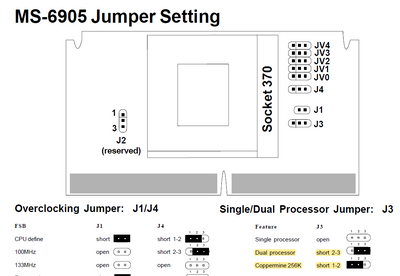OK so an update, my board turned out to be a rev 1.06 D02 which has the latest/necessary voltage regulator chips HIP 6019 BCB & HIP 6004BCB to drive lower voltage CPU's such as PIII-S 1.4Ghz. I have the old 9150 clock gen chip which I confirmed with SoftFSB wont produce a proper signal at 133Mhz it downclocks the CPU's (I forgot exactly what but it was lower than 112Mhz FSB). Anyway it will run reliably at 112Mhz which for now is good enough. So far it seems that the Slot 1 sockets on the motherboard might be a bit flaky.
2x PIII Coppermine (slot 1 100Mhz FSB spec) 700's @ 784Mhz 0r @ 700Mhzrun fine both are slot 1 CPU's and seem to be recognized fine as a pair unless disturbed then can be a bit of a hassle to get them to both be recognized at POST time but otherwise runs fine with Windows 2K, Haiku and BeOS, installed Lubuntu LTS and ran fine. 1gb of 133Mhz ram in this configuration runs fine. Its been running fine with these since I built it 10 days ago then last night I tried the Slot0T's and became aware of problems as below.
2x Upgradeware Slot-T with 2x Tualatin 1.4S, bit of a pain to be honest, very flaky getting both CPU's to be recognized at POST time. multiple remove and inserts (reseating) seems to work a little, blown slots out with airduster, cleaned Slot-T edge connector with rubber eraser, also polished with lint cloth and tiny bit of metal polish as they where tarnished. When system posts, BIOS POST screen sometimes corrupted with oddities, also hits and miss how much memory is reported seems to see 1.5 sticks sometimes???. Remove 2 sticks, leave 2 in, 512MB so posts a bit better then when running Windows 2K getting BSOD with some kernel error. Sorry to be a bit vague but it was going on last night and it was late. Could not install Lubuntu got a couple of kernel panics and also crashes.
I think the connection of the slot closest to the ram and the Slot-T in it is the problem, I have swapped Slot-T's, same, checked voltage jumpers 1.45v as it should be (confirmed with CPU-Z). But sometimes getting this slot to recognize something is plugged can be a little difficult, the proper Slot 1 CPU's I have being the easiest and most reliable.
POST screen reports them as Tualatin Celerons even though they are full fat 1.4-S??
I did try a couple of S370 PIII 1Ghz Coppermines (1Mhz FSB ones) I have and maybe they where better but would not run with 112FSB, I didn't test for long, I tried them when the Tualatins would not POST before I realized one socket was not making good contact.
I have the 1014d.003 Beta BIOS which I used BIOS Patcher 4.23 to fix as my DVD drive disconnected randomly before I did the BIOS patch.
Not sure what's going on here, anybody got any tips or observations?
Any ideas how to clean or improve the connector quality between the edge connector and the slot?
Thanks
BeBox PPC Dual 133, NeXTCube Turbo - Dimension, NeXTStation Turbo Color, SGI Octane R12k x2 MXE Impact, Alienware 15r3 GTX 1080, MacBook Pro Retina 2012, Macintosh Plus, Macintosh Quadra 840av, Macintosh Quadra 650, Wallstreet 500 (G4), Pismo 550 (G4).
